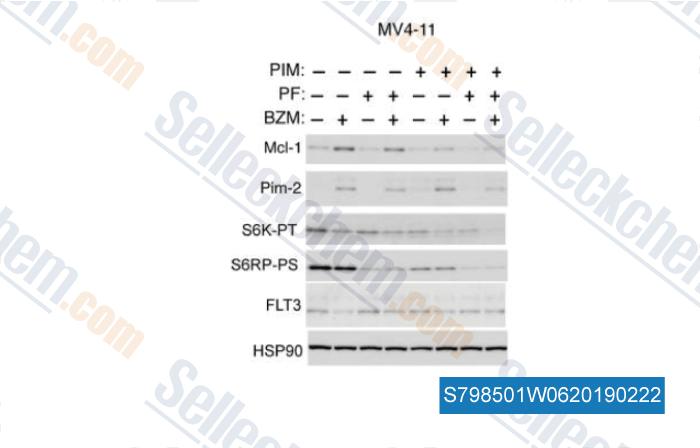|
Toll Free: (877) 796-6397 -- USA and Canada only -- |
Fax: +1-832-582-8590 Orders: +1-832-582-8158 |
Tech Support: +1-832-582-8158 Ext:3 Please provide your Order Number in the email. |
Technical Data
| Formula | C24H23F3N4O.HCl |
|||
| Molecular Weight | 476.92 | CAS No. | 1210416-52-6 | |
| Solubility (25°C)* | In vitro | DMSO | 88 mg/mL (184.51 mM) | |
| Ethanol | 88 mg/mL (184.51 mM) | |||
| Water | Insoluble | |||
|
* <1 mg/ml means slightly soluble or insoluble. * Please note that Selleck tests the solubility of all compounds in-house, and the actual solubility may differ slightly from published values. This is normal and is due to slight batch-to-batch variations. * Room temperature shipping (Stability testing shows this product can be shipped without any cooling measures.) |
||||
Preparing Stock Solutions
Biological Activity
| Description | PIM447 (LGH447) Hydrochloride is a novel pan-PIM kinase inhibitor with Ki values of 6 pM, 18 pM, 9 pM for PIM1, PIM2, PIM3 respectively. It also inhibits GSK3β, PKN1, and PKCτ, but at a significantly lower potency with IC50 between 1 and 5 μM (>105-fold differential relative to the Ki on PIMs). PIM447 induces apoptosis. | ||||||
|---|---|---|---|---|---|---|---|
| Targets |
|
||||||
| In vitro | The kinase selectivity of PIM447 is first determined in biochemical assays for a panel of 68 diverse protein kinases that included PIM2 as well as 9 lipid kinases. In this panel, only PIM2 is significantly inhibited by PIM447 with an IC50 of <0.003 μM, the lowest sensitivity range for the assay. PIM447 also inhibits GSK3β, PKN1, and PKCτ, but at a significantly lower potency with IC50 between 1 and 5 μM (>105-fold differential relative to the Ki on PIMs). The biochemical IC50 for all other kinases tested in this panel is >9 μM. In follow-up cellular assays of GSK3β inhibition, PIM447 is tested up to 20 μM and is not active[1]. PIM447 is cytotoxic for myeloma cells due to cell-cycle disruption and induction of apoptosis mediated by a decrease in phospho-Bad (Ser112) and c-Myc levels and the inhibition of mTORC1 pathway. PIM447 also inhibits in vitro osteoclast formation and resorption, downregulates key molecules involved in these processes, and partially disrupts the F-actin ring, while increasing osteoblast activity and mineralization[2]. | ||||||
| In vivo | Low to moderate in vivo CL is observed for PIM447 across species, as CL values of 20, 28, and 8 mL/min/kg are observed in mouse, rat, and dog, respectively. The volume of distribution is consistently large across species, with Vss of 5.3, 6.4, and 3.6 L/kg observed in mouse, rat, and dog, respectively. Additionally, PIM447 exhibits high oral bioavailability across species, as 84%, 70%, and 71% is observed in mouse, rat, and dog, respectively. The stability of PIM447 in human plasma is high, >90% after a 3 h incubation, and the human plasma protein binding of PIM447 is 95%. With the combination of potent in vitro activity and low to moderate CL, PIM447 demonstrates in vivo target modulation (pS6RP), single agent antitumor activity in a KG-1 AML mouse xenograft model, and druglike properties suitable for development[1]. PIM447 significantly reduces the tumor burden and prevents tumor-associated bone loss in a disseminated murine model of human myeloma[2]. |
Protocol (from reference)
| Cell Assay: |
|
|---|---|
| Animal Study: |
|
References
|
Customer Product Validation

-
Data from [Data independently produced by , , Transl Oncol, 2018, 12(2):336-349]
Selleck's PIM447 (LGH447) Hydrochloride has been cited by 22 publications
| PIM1 drives lipid droplet accumulation to promote proliferation and survival in prostate cancer [ Oncogene, 2024, 43(6):406-419] | PubMed: 38097734 |
| PIM1 is a potential therapeutic target for the leukemogenic effects mediated by JAK/STAT pathway mutations in T-ALL/LBL [ NPJ Precis Oncol, 2024, 8(1):152] | PubMed: 39033228 |
| Inhibition of Pim kinases triggers a broad antiviral activity by affecting innate immunity and via the PI3K-Akt-mTOR axis the endolysosomal system [ Antiviral Res, 2024, 226:105891] | PubMed: 38649071 |
| The role of Pim-1 kinases in inflammatory signaling pathways [ Inflamm Res, 2024, 10.1007/s00011-024-01924-2] | PubMed: 39079978 |
| Nuclear transport surveillance of p53 by nuclear pores in glioblastoma [ Cell Rep, 2023, S2211-1247(23)00893-8] | PubMed: 37552992 |
| PIM1 phosphorylates ABI2 to enhance actin dynamics and promote tumor invasion [ J Cell Biol, 2023, 222(6)e202208136] | PubMed: 37042842 |
| PIM1 phosphorylates ABI2 to enhance actin dynamics and promote tumor invasion [ J Cell Biol, 2023, 222(6)e202208136] | PubMed: 37042842 |
| Defining the Role of PIM in Regulating Cytoskeletal Dynamics and Tumor Cell Invasion in Hypoxia [ The University of Arizona., 2023, ] | PubMed: None |
| Inhibition of PIM Kinases in DLBCL Targets MYC Transcriptional Program and Augments the Efficacy of Anti-CD20 Antibodies [ Cancer Res, 2021, canres.1023.2021] | PubMed: 34625423 |
| Inhibition of PIM Kinases in DLBCL Targets MYC Transcriptional Program and Augments the Efficacy of Anti-CD20 Antibodies [ Cancer Res, 2021, 81(23):6029-6043] | PubMed: 34625423 |
RETURN POLICY
Selleck Chemical’s Unconditional Return Policy ensures a smooth online shopping experience for our customers. If you are in any way unsatisfied with your purchase, you may return any item(s) within 7 days of receiving it. In the event of product quality issues, either protocol related or product related problems, you may return any item(s) within 365 days from the original purchase date. Please follow the instructions below when returning products.
SHIPPING AND STORAGE
Selleck products are transported at room temperature. If you receive the product at room temperature, please rest assured, the Selleck Quality Inspection Department has conducted experiments to verify that the normal temperature placement of one month will not affect the biological activity of powder products. After collecting, please store the product according to the requirements described in the datasheet. Most Selleck products are stable under the recommended conditions.
NOT FOR HUMAN, VETERINARY DIAGNOSTIC OR THERAPEUTIC USE.
